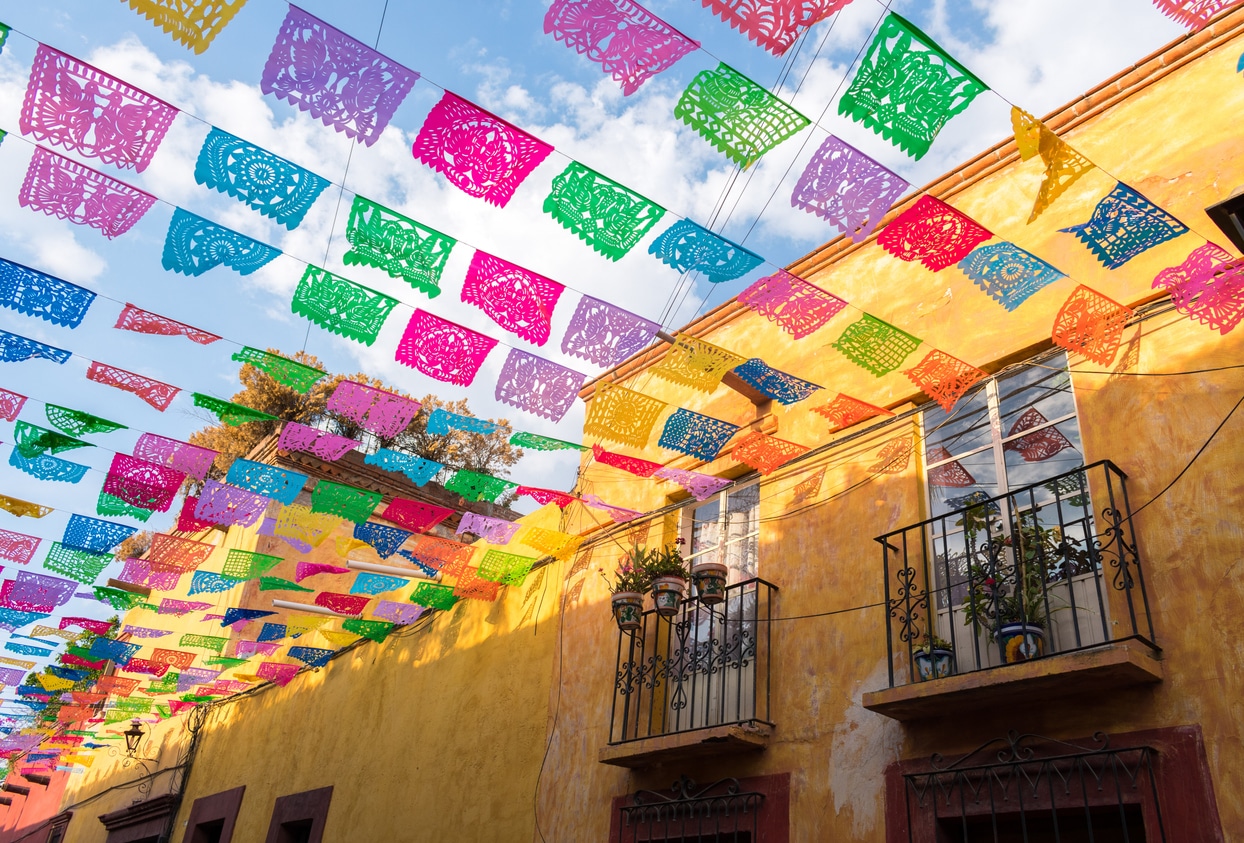If you’ve ever dreamed of trading snow shovels for beach towels, or rush-hour traffic for a slow stroll to the mercado, you might be ready to retire in Mexico. For U.S. citizens (and more than a few Canadians), it’s become the go-to spot for sunshine, vibrant culture, and a cost of living that won’t eat your entire retirement budget.
But Mexico’s appeal goes well beyond the margaritas and mariachi soundtrack. From historic cities bursting with color to coastal towns where fresh fish tacos cost less than your morning latte back home, it offers a lifestyle that’s hard to beat — especially when you can do it for less.
And for those ready to make the leap, the real magic is in how easy it can be to settle in—warm weather, welcoming neighbors, and the kind of daily rhythm that makes you wonder why you didn’t move sooner.
Key 2025 Updates
- Temporary residency now generally requires $4,000–$4,400 USD per month or $70,000–$80,000 USD in savings, varying by consulate and exchange rate.
- Permanent residency thresholds have dropped to about $7,100 USD monthly income or $280,000 USD in savings, down from 2024 levels.
- Visa income rules remain tied to UMA or minimum wage standards, with no increases announced for 2025.
How much money do you need to retire in Mexico?
Some retirees in Mexico spend less each month than they used to on basic housing costs back in the U.S. Others treat retirement as an upgrade — nicer home, more travel, and all the fresh-squeezed juice they can drink—and still come out ahead. In most cases, $1,800–$3,000 USD per month covers a comfortable lifestyle, with plenty of wiggle room for extras.
To live here legally, you’ll need to pass Mexico’s financial solvency test. For 2025, that means showing proof of about $4,100 USD in monthly income or $70,000 USD in savings. The numbers shift slightly depending on the consulate, but the idea is the same: you can support yourself without working locally.
The peso (MXN) rules the day-to-day economy, and learning to think in pesos — not just dollars — can help you spot a deal, avoid tourist markups, and feel like part of the local rhythm.
When mapping out your spending, budget for:
- Housing: A two-bedroom apartment in a mid-sized city might run $600–$900 USD; a beachfront spot in a resort town can top $1,500.
- Utilities: Modest bills most of the year, but high AC use in hot months can double your electricity costs.
- Groceries and dining: Fresh produce, tortillas, and local meats are cheap; imported wine and cheese are splurges.
- Healthcare: Even private clinics are often a fraction of U.S. prices, with short wait times and high-quality care.
- Entertainment and travel: From concerts in the plaza to overnight bus trips to another region, it’s worth setting aside a small monthly fund.
The beauty of Mexico’s lower cost of living is that it lets you decide where to spend and where to save — without feeling like you’re sacrificing comfort or fun.
💡 Pro Tip:
Don’t underestimate the value of walkability. Choosing a neighborhood where you can run errands and enjoy daily life on foot can save you money and help you settle in faster.
Cost of living in Mexico: What to expect
Mexico’s low cost of living is one of its biggest selling points for retirees, whether you settle in a bustling capital or a sleepy coastal town. Your monthly budget will hinge on location, lifestyle, and whether you’re renting or buying — but across the board, daily expenses are often far below what you’d pay in the U.S., Canada, or much of the Caribbean.
Here’s a look at what you might expect in different popular retirement spots:
- Puerto Vallarta (beachfront living): Modern one-bedroom apartments near the water can rent for $1,200–$1,800 USD; budget $15–$20 for a fresh seafood dinner with drinks.
- Mérida (Yucatán Peninsula): A colonial home in the city center may rent for $700–$1,000 USD, with local meals under $5 and minimal transport costs thanks to walkable neighborhoods.
- Lake Chapala and Ajijic: Known for their vibrant expat communities, rentals run $600–$1,200 USD; the mild climate keeps utility bills low.
- Mazatlán (Pacific coast): Beachside condos start around $800–$1,300 USD per month, and you’ll pay $0.50–$0.75 for a city bus ride.
Beyond rent, here’s what to factor into your budget as a resident of Mexico:
- Food: Local markets and street stalls offer incredible value; imported goods and specialty products cost more.
- Transportation: Public buses, colectivos, and rideshares are cheap; car ownership adds insurance, fuel, and maintenance.
- Healthcare: Medicare doesn’t apply here, but private insurance is affordable, and many expats pay cash for routine care.
- Real estate: Owning property can reduce long-term housing costs, but you’ll need to account for taxes, maintenance, and HOA fees.
If you’re earning in USD — whether from a Social Security benefit or other income — your money often goes further than for locals paid in pesos. That financial advantage makes Mexico not just a beautiful retirement destination, but a practical one.
💡 Pro Tip:
The biggest “hidden” expense for beachfront living isn’t rent — it’s air conditioning. Factor in higher electricity bills if you love a cool home in tropical heat.
Legal residency options for U.S. retirees
For U.S. retirees, legal residency is the key to living in Mexico long-term without visa runs. Most choose between two main paths: the temporary resident visa (good for one to four years) and the permanent resident visa (no renewals required). Both let you open a bank account, sign a lease, and fully enjoy your new life — whether that’s in Mexico City, a Mayan beach town, or another popular destination.
The process typically starts at a Mexican consulate in your home country — such as the one in Houston — where you’ll apply and prove you meet financial requirements. In 2025, that usually means:
- Temporary residency: Proof of roughly $3,300 USD in monthly income (from pensions, Social Security, or investments) or savings of about $55,000 USD.
- Permanent residency: Proof of around $5,500 USD in monthly income or higher savings, with requirements varying by consulate.
You’ll also need to provide:
- A valid passport and recent photos.
- Bank statements or pension letters showing consistent income or savings.
- Completed application forms and payment of consular fees.
Many retirees start with temporary residency to “test-drive” life in Mexico. After four years, you can transition to permanent residency without reapplying from abroad.
💡 Pro Tip:
Financial thresholds can vary from one consulate to another, so always check your chosen location’s website before applying — and bring more documentation than you think you’ll need.
Can Americans collect Social Security in Mexico?
For many Americans, Social Security benefits are the backbone of their retirement income — and moving to Mexico doesn’t change that. The U.S. government will keep sending your payments, even if your new morning routine involves ocean views and fresh pan dulce instead of a commute.
You can choose to have your monthly benefit:
- Deposited into a U.S. bank account: Ideal if you still have bills or investments stateside, with pesos transferred only when needed.
- Deposited into a Mexican bank account: Handy for everyday spending, though you’ll want to account for transfer times, exchange rates, and bank fees.
Plenty of retirees keep a U.S. account and simply withdraw pesos through local ATMs or make online transfers. This gives you more control over conversion timing — which can mean more tacos for the same dollar when the rate is in your favor.
If you’re Canadian or splitting time between countries, check in with the Social Security Administration (SSA) or Service Canada to confirm current rules and the best payment setup for your situation.
💡 Pro Tip:
Exchange rates can quietly nibble at your budget — or boost it. Track the peso’s movement and plan transfers strategically.
Healthcare in Mexico for retirees
For retirees, healthcare isn’t just a line item — it’s peace of mind. Moving to Mexico means thinking carefully about how you’ll access care and making sure you have coverage that works for your needs and budget. The good news? Mexico offers affordable, high-quality healthcare in both public and private systems.
- Public healthcare (IMSS or INSABI): Available to residents for a low monthly fee or, in some cases, free. Coverage includes doctor visits, hospital stays, and prescriptions, but facilities can be basic, and wait times longer.
- Private healthcare: Faster service, more amenities, and access to top-tier hospitals — still at a fraction of U.S. prices. Many expats choose private insurance or pay out-of-pocket for routine care.
Health insurance options range from joining the public healthcare system to buying private expat insurance that covers you in Mexico and abroad. Premiums depend on age, health, and coverage level, but even comprehensive plans often cost less than basic U.S. coverage.
In popular expat hubs, English-speaking doctors and internationally accredited medical facilities are easy to find. Wait times are generally shorter than in Canada’s public system, and specialist visits or dental work can be surprisingly affordable.
💡 Pro Tip:
Even if you join the public system, keeping private insurance gives you more flexibility, faster appointments, and a safety net for specialized treatment and medical care.
Taxes for Americans retiring in Mexico
Retiring in Mexico comes with a lot of perks, but freedom from taxes isn’t one of them. Whether you’ll owe Mexican income tax depends on two key factors: where your income comes from and whether you’re considered a Mexican tax resident. If most or all of your money comes from U.S. sources like Social Security, pensions, or investment withdrawals, you may not owe tax in Mexico — but you still need to understand the residency rules.
And one thing never changes: U.S. citizens must file a U.S. tax return every single year, no matter where they live. The IRS doesn’t care if your new home has palm trees instead of pine trees.
Here’s what to keep in mind:
- Mexican tax residency: Generally triggered if you spend more than 183 days in the country or your “center of vital interests” is there (for example, your spouse or main home is in Mexico).
- U.S. filing obligations: Annual Form 1040, plus possible FBAR and FATCA reporting for foreign bank accounts and investments.
- Double taxation risks: Income earned in Mexico (like rental income or local employment) may be taxed in both countries unless you use the Foreign Earned Income Exclusion or foreign tax credits.
- Property ownership: Mexico taxes capital gains on real estate sales, though exemptions may apply for a primary residence. Property taxes are generally lower than in the U.S. but vary by municipality.
- Currency considerations: If you receive income in USD but spend in pesos, exchange rates can affect the taxable amount you report to the IRS.
Owning assets or earning income on both sides of the border means more moving parts — and more room for costly mistakes if you’re not careful.
💡 Pro Tip:
A cross-border tax specialist can help you coordinate your filings, maximize exclusions and credits, and avoid paying more than you owe in either country — all while keeping you in the IRS’s good books.
Best cities and coastal towns to retire in Mexico
Choosing the right spot to retire in Mexico is as much about lifestyle as it is about budget. Do you picture yourself wandering cobblestone streets with an espresso in hand, or watching the sunset over the ocean from your balcony? Mexico has options for every vibe — from bustling cities to sleepy beach towns.
Some favorites among retirees include:
- San Miguel de Allende: Artsy, walkable, and packed with galleries, festivals, and a strong expat community.
- Mérida: Known for its safety, cultural richness, and access to the beaches of the Yucatán Peninsula.
- Puerto Vallarta, Playa del Carmen, Cancún, Mazatlán, Cabo: All offer beach living with solid infrastructure, healthcare options, and plenty of amenities.
- Querétaro: A modern, affordable, and less touristy city with a growing expat presence.
- Lake Chapala & Ajijic: Classic expat hubs with a tight-knit community, mild climate, and easy pace of life.
When it comes to safety, many retirees gravitate toward cities like Mérida and Querétaro, which consistently rank among Mexico’s safest. That said, even in beach towns, expat-heavy neighborhoods often have a strong sense of security and community.
While English is widely spoken in popular retirement destinations, learning some Spanish can open doors — to local friendships, better deals at markets, and a deeper sense of belonging.
💡 Pro Tip:
If you’re torn between the buzz of city life and the tranquility of a small town, consider renting in each for a few months before committing. The difference in pace (and noise levels) can be bigger than you expect.
Is it safe to retire in Mexico?
Safety in Mexico is one of the most common concerns for would-be retirees — and one of the most misunderstood. Yes, there are areas with higher crime rates (just as there are in the U.S. and Canada), but many parts of Mexico are not only safe, they’re thriving expat communities where people live comfortably for decades.
The reality is that your personal safety often depends more on where you choose to live and how you navigate day-to-day life than on the country as a whole. Cities like Querétaro, Mérida, and Ajijic consistently rank among Mexico’s safest, while even in larger cities like Guadalajara, expats often live in well-established neighborhoods with strong community ties.
Practical safety tips for retirees include:
- Research before you relocate: Crime rates and safety conditions vary by city and even by neighborhood.
- Blend in: Flashy jewelry and obvious displays of wealth can make you a target.
- Stay street smart: Use official taxis or ride-shares, avoid poorly lit areas at night, and stay aware of your surroundings.
- Learn basic Spanish: It’s invaluable for emergencies and helps you build rapport with neighbors and locals.
- Know your local contacts: Having a list of emergency numbers, nearby hospitals, and trusted friends or neighbors can be a lifesaver.
💡 Pro Tip:
Many long-term expats say they feel safer in their Mexican communities than they did back home — but that comfort comes from making smart choices and staying informed.
Is retiring in Mexico right for you?
Retiring in Mexico can be as lively or laid-back as you want it to be — from sipping coffee in a big-city plaza to watching the waves roll in from your balcony. With lower living costs, welcoming communities, and a climate that encourages more flip-flops than snow boots, it’s no wonder so many Americans are making the move.
Of course, life abroad also comes with its own set of financial and tax considerations — and that’s where Bright!Tax comes in. We specialize in helping U.S. expats stay compliant, cut through tax complexity, and keep more of their hard-earned retirement income.
If you’re ready to trade winter coats for warm breezes, get in touch and we’ll make sure your tax strategy is as sunny as your new address.
Frequently Asked Questions
-
Can Americans collect Social Security while living in Mexico?
Yes. The SSA will send payments to a U.S. or Mexican bank account, though some retirees prefer keeping a U.S. account for exchange rate stability.
-
Do I need to pay taxes in both Mexico and the U.S.?
If you’re a U.S. citizen, you must still file U.S. tax returns no matter where you live. Whether you owe tax in Mexico depends on your residency status and income source.
-
Is healthcare in Mexico good for retirees?
Yes. Mexico offers high-quality private healthcare at a fraction of U.S. costs, with many English-speaking doctors in expat-heavy areas.
-
How much money do I need to retire in Mexico?
Many retirees live comfortably on $2,000–$3,000 USD per month, though big-city or beachfront living can cost more.
-
Do I need to speak Spanish to live in Mexico?
No, but it will make daily life easier, help in emergencies, and deepen your connection with the community.
-
Is Mexico safe for retirees?
Safety varies by location. Many expats choose cities like Mérida, Querétaro, or Ajijic for their low crime rates and strong community feel.

 Connect on LinkedIn
Connect on LinkedIn

